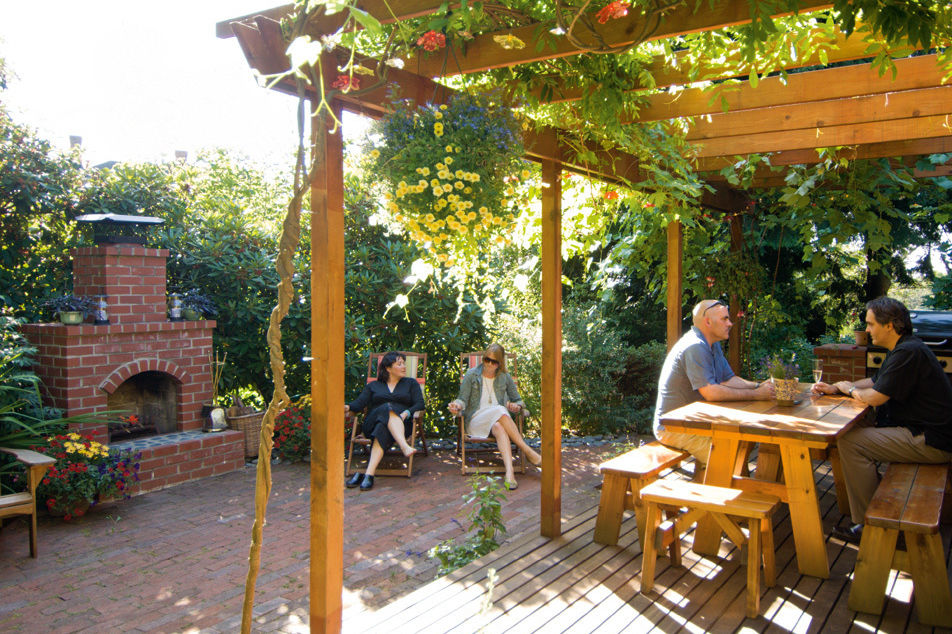Backyard Habitat Certification
As anyone who’s met me lately at a cocktail party can attest, I rattle on a lot about the native insects in my back garden. (Ever since I joined the Xerces Society, I’ve been a total pest about bugs!)
So when I found out about the Backyard Habitat Certification Program, a partnership of the Audubon Society, Three Rivers Land Conservancy and the East Multnomah County Water District, I immediately signed myself up.
This program is designed to help Portland area homeowners restore native wildlife habitat in their yards – that means for bees, birds, lizards (if you’re lucky), and other creatures. Oh, and plants, of course! For $25, you receive useful educational materials, valuable resources to help you get started (low-cost plants, coupons and gift cards) and individual feedback on your garden’s habitat-friendliness. The focus is on removing noxious weeds, replanting Willamette Valley native plants, managing storm water and basically creating beneficial habitat for native wildlife.
It all starts with a home site assessment. For this, a knowledgeable backyard certification staff person comes to your yard for a site visit. Together, you tromp around and notes are taken on invasive weeds, storm water issues (impervious surfaces, whether IPM methods are used, etc). Any existing native plants are noted and, if you qualify, the level of certification for which you qualify is awarded on the spot and you’ll receive advice on moving up to the next level. If you aren’t quite there yet, you’ll receive detailed information about how to create more valuable habitat for wildlife so that you can be certified.
There are three levels of certification. Silver is the first level – this was my certification level because I have 5% native cover. When I increase the native cover in my garden to 15%, and take further steps to create still better habitat for wildlife (such as installing a water feature for birds and butterflies to splash about in – or an orchard mason bee house) I would certify for second level "gold" status. Platinum level certification is the "top" level.
The walk-through was fascinating! As we strolled and talked, it was observed that I had an invasive species in my garden – a rather lovely white-flowered, cream-variegated leafed money plant (Lunaria annua ‘Variegata Alba’). I guess I hoped they wouldn’t recognize it (I do remove the tops after they finish flowering) but Galen Beatty (of Three Rivers Land Conservancy) and Karen Munday (Portland Audubon) know their plants. True, it’s variegated and marginally less aggressive than the straight green leafed, purple-flowered form. (There’s a picture in the slideshow.) But I do notice that it throws out the occasional green-leafed reversion. So out it will come, in the name of good environmental stewardship!
After the site visit, I received a Home Visit Assessment Report which detailed my property and the watershed I belong to. It outlined everything we discussed during the site visit, including the wildlife-friendly qualities of my garden and the steps I would need to take to make it increasingly wildlife friendly over time.
I also received an amazing wealth of resources including a fat Naturescaping binder providing all the basic information needed to envision and then create a haven for wildlife in your garden. Why are native insects important? What kind of a garden design is most useful to native birds? This volume addresses these questions, and provides planting diagrams and plans and numerous plant lists.
In addition, I got a file folder with more resources and ideas for cultivating the four main elements of the program: removing invasive plants and cultivating natives, developing a stormwater plan on your property, and attracting and preserving wildlife.
I am now the proud owner a sign which I will post near the front of my garden so that people who see the sign will ask me how I got it! Their goal is to help Portlanders think about and work toward creating a rich and diverse habitat for native wildlife. I’m all for it. How about you?





